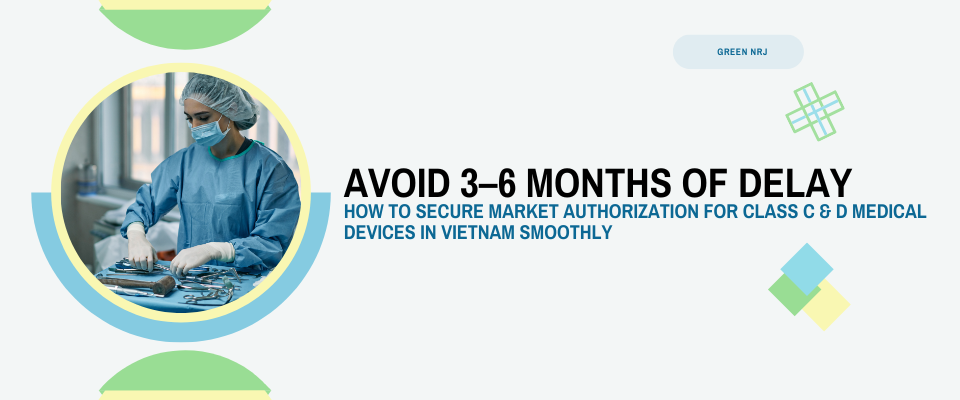- If you have any questions, please contact us!
- +84 965 624 065
- info@greennrj.com.vn
How to Successfully Import Class C and D Medical Devices into Vietnam (2025 Complete Guide)

Class B Medical Devices: Simplified Import Procedures into Vietnam (2025)
July 2, 2025
Self-Declaration of Food Packaging and Food Contact Materials in Vietnam: The Ultimate 2025 Success Guide
July 8, 2025How to Successfully Import Class C and D Medical Devices into Vietnam (2025 Complete Guide)
Import Class C and D medical devices into Vietnam requires a detailed understanding of current regulations and procedures, especially as the country tightens oversight in 2025. These higher-risk medical products must go through mandatory registration processes — including obtaining a Marketing Authorization Number — before they can legally enter the Vietnamese market. Local distributors are also subject to licensing requirements to ensure safe and compliant distribution.
In fact, understanding these procedures in detail is crucial for any manufacturer or distributor planning to operate in Vietnam. This guide outlines each essential step clearly, from proper classification and circulation registration to the final customs process and licensing requirements. By following these steps, companies can minimize regulatory delays, strengthen compliance, and build greater trust among healthcare providers throughout the country.
Introduction
Vietnam has emerged as one of the most promising markets for medical devices in Asia, drawing strong interest from global manufacturers and distributors. When it comes to Class C and D devices — those considered to carry higher risks to patients and end users — the Ministry of Health enforces strict oversight and comprehensive regulatory measures. Successfully navigating these detailed requirements is not just about ticking boxes; it is essential for legal compliance, protecting patient safety, and establishing long-term credibility with local hospitals and healthcare professionals.
Why it matters: Key legal points
-
Class C and D devices face stricter regulatory controls due to higher risk.
-
A valid Marketing Authorization Number (Vietnam Registration Number) is mandatory before import for all Class C and D devices.
- All temporary extension provisions allowing the importation or circulation of medical devices without a Marketing Authorization Number, as stipulated in previous legal documents (such as Decree 07/2023/NĐ-CP and Resolution 30/NQ-CP), expired on December 31, 2024.
-
Most devices no longer require a separate import license if this number is granted.
-
Customs clearance demands accurate documents in line with MOH requirements.
-
Local distributors must hold a Certificate of Eligibility for Trading Medical Devices, covering Class B, C, and D.
Classification and circulation registration
Classification of medical devices
Under Decree 98/2021/NĐ-CP, all medical devices imported or distributed in Vietnam are classified into four categories based on the level of risk they pose to patients and users:
-
Class A: Low risk (e.g., simple medical supplies such as bandages or thermometers).
-
Class B: Low to moderate risk (e.g., syringes, surgical gloves).
-
Class C: Moderate to high risk (e.g., infusion pumps, ultrasound systems).
-
Class D: High risk (e.g., implantable pacemakers, heart valves).
The classification process must comply strictly with Circular 05/2022/TT-BYT, which provides specific guidelines and risk assessment criteria.
According to these regulations, classification is not conducted by the Ministry of Health directly but rather by the registrant — typically the manufacturer’s authorized representative in Vietnam, an importer, or a local legal entity appointed by the foreign manufacturer.
After self-classification, the registrant must prepare a classification result dossier, which is then submitted as part of the circulation registration application. In cases where the Ministry of Health deems necessary, it may review or re-assess the classification to ensure accuracy and compliance.
This self-classification mechanism is designed to streamline administrative procedures, but it also places significant responsibility on the registrant to ensure honesty and accuracy. Incorrect classification can lead to serious penalties, including suspension of distribution rights or revocation of the Marketing Authorization Number.
Circulation registration and Marketing Authorization Number
Before they can be imported and circulated in Vietnam, all Class C and D medical devices are required to obtain a Marketing Authorization Number (also known as the Vietnam Registration Number). This is a mandatory step under Decree 98/2021/NĐ-CP, ensuring that each device meets the Ministry of Health’s safety and performance standards.
To apply for this authorization, the registrant — typically the authorized representative or importer in Vietnam — must prepare and submit a comprehensive dossier. Key documents include:
| Document | Details & Requirements |
|---|---|
| Written Request for New Circulation Number | Official application letter prepared by the registrant, requesting issuance of a Marketing Authorization Number. |
| Medical Device Classification Result | The classification report confirming device risk class (C or D) according to Decree 98/2021/NĐ-CP and Circular 05/2022/TT-BYT. |
| ISO 13485 Certificate | Scanned copy proving compliance with international quality management standards. |
| Certificate of Free Sale (CFS) | Must be legalized and translated into Vietnamese; proves product is legally sold in other markets. |
| Letter of Authorization / Power of Attorney | Issued by the manufacturer or brand owner, notarized, legalized, and translated into Vietnamese. |
| Warranty Confirmation Letter | Legalized and translated confirmation of warranty eligibility or non-warranty declaration. |
| Clinical Evidence or SSCP | Scanned copy providing safety and clinical performance data. |
| Product Catalog | Scanned copy detailing product specifications and variants. |
| User Manual | Scanned copy, usually in English and/or Vietnamese, guiding safe and correct use. |
| Product Labels | Scanned copies of main and secondary labels complying with local requirements. |
| Business Registration Certificate | Of the authorized Vietnamese representative or importer. |
| CSDT Inspection Record & CSDT Dossier | Issued after submission; required for standard product registration. |
| Account & Password for Online Portal | Required to access Vietnam’s registration system. |
Once approved, the Marketing Authorization Number is valid for five years, after which it can be renewed following a similar procedure.
Failure to obtain this authorization before importation can result in confiscation of goods, administrative fines, or revocation of trading rights. Therefore, careful preparation and thorough compliance at this stage are crucial for any company looking to introduce Class C and D medical devices into Vietnam’s healthcare market.
Import and customs procedures
No separate import license required (with a Valid Marketing Authorization Number)
According to Article 48 of Decree 98/2021/NĐ-CP (as amended and supplemented by Decree 07/2023/NĐ-CP and Decree 04/2025/NĐ-CP), most Class C and D medical devices can be imported into Vietnam without a separate import license, provided that the device already has a valid Marketing Authorization Number (Vietnam Registration Number). This policy significantly reduces administrative complexity and speeds up the import process for qualified products.
Important Note for 2025:
All general temporary extension provisions (such as those under Decree 07/2023/NĐ-CP and Resolution No. 30/NQ-CP) which previously allowed the import or circulation of medical devices without a Marketing Authorization Number, expired on December 31, 2024.
However Decree 04/2025/NĐ-CP has introduced specific transitional provisions for certain categories of medical devices. From January 1, 2025, until December 31, 2025, some medical devices (specifically, certain in-vitro diagnostic medical devices and Class B, C, D medical devices that were previously granted import licenses between January 1, 2018, and December 31, 2021) may still be imported without a separate import license, even if they have not yet obtained a Marketing Authorization Number.
For all other Class C and D medical devices not falling under these specific extended categories, a valid Marketing Authorization Number issued under Decree 98/2021/NĐ-CP (as amended and supplemented) is strictly required for import and circulation as of January 1, 2025.
However, it’s crucial to note that this exemption does not apply to devices subject to special management or those classified as restricted by separate regulations.
Customs clearance documentation
For customs clearance, importers are required to prepare and submit a comprehensive set of documents in accordance with the Law on Customs and specific guidance from the Ministry of Health (MOH). Essential documents typically include:
-
Marketing Authorization Number certificate (proof that the device is legally approved for circulation in Vietnam).
-
Bill of lading (transportation document issued by the carrier).
-
Commercial invoice (details the value and terms of the shipment).
-
Packing list (lists all items contained in the shipment, including packaging details).
-
Certificate of Origin (C/O) (proves the manufacturing origin, which may be required for tax or preferential tariff purposes).
-
Customs declaration form (the official form submitted to Vietnamese customs to initiate clearance).
In some cases, especially for high-risk or sensitive devices, customs authorities or the Ministry of Health may request additional supporting documents, on-site inspections, or product samples to verify conformity and safety.
Trading license for distribution
In order to legally distribute Class B, C, and D medical devices in Vietnam, companies must obtain a Certificate of Eligibility for Trading Medical Devices. This certificate confirms that the distributor can safely handle higher-risk products.
Key requirements include appointing a qualified technical manager with relevant medical or engineering credentials, maintaining proper storage facilities that meet quality standards, and establishing documented procedures for monitoring product quality, handling complaints, and managing recalls.
Required documents typically include:
| Document | Details |
|---|---|
| Declaration of eligibility for trading medical devices | Official request form for trading certificate. |
| Staff declaration form | Confirms employment and roles of staff. |
| House lease or loan agreement | Proof of business address. |
| Vehicle registration certificate | Proof of delivery capability (if applicable). |
| Qualifications of technical staff | Degrees or certificates of technical manager and relevant staff. |
Meeting these conditions not only fulfills legal obligations but also strengthens trust with hospitals and patients, reinforcing the distributor’s credibility in Vietnam’s healthcare market.
Frequently Asked Questions (FAQs)
1 What are Class C and D medical devices in Vietnam?
Class C and D medical devices are categorized as medium- to high-risk products under Vietnam’s Decree 98/2021/NĐ-CP. Class C includes items like infusion pumps and diagnostic imaging equipment, while Class D covers higher-risk products such as implantable pacemakers, heart valves, and life-support systems. These devices are subject to stricter regulatory controls and must undergo full registration before being imported or distributed.
2 Do I need a license to import Class C and D medical devices into Vietnam?
Yes. To import Class C and D medical devices into Vietnam, the importer must first obtain a Marketing Authorization Number issued by the Ministry of Health. Without this number, customs clearance is not allowed, except under specific transitional provisions that may apply in limited cases (e.g., until June 30, 2025, per Decree 04/2025/NĐ-CP).
3 How do I register Class C and D medical devices in Vietnam?
To register these devices, you must submit a complete dossier including classification results, ISO 13485 certificate, Certificate of Free Sale (CFS), product labels, manuals, and more. Once approved, a Vietnam Registration Number (Marketing Authorization Number) will be issued, valid for five years. This is a legal requirement for importing and distributing Class C and D devices in the country.
4 Can I import Class C and D devices without a separate import license?
In most cases, yes — provided that your device already has a valid Marketing Authorization Number. According to Decree 98/2021/NĐ-CP (amended), a separate import license is no longer required for most Class C and D medical devices. However, exceptions exist for products under special management or those lacking registration approval after June 30, 2025.
5 What are the distribution requirements for Class C and D devices in Vietnam?
To legally distribute Class B, C, and D devices in Vietnam, companies must obtain a Certificate of Eligibility for Trading Medical Devices. This includes having qualified technical staff, proper storage facilities, and internal quality procedures. Without this license, distribution activities will not be recognized under Vietnamese law.
Conclusion
Importing Class C and D medical devices into Vietnam requires meticulous preparation and strict adherence to local regulations. From securing a valid Marketing Authorization Number to navigating customs clearance and partnering with properly licensed distributors, each step is critical to ensuring smooth market entry and long-term success.
As Vietnam’s healthcare sector rapidly expands, compliance is not just a legal obligation — it is key to building credibility and gaining trust among hospitals, doctors, and patients.
At Green NRJ, we specialize in regulatory strategy and local registrations for medical devices. Our experienced team can support you throughout the entire process, helping you minimize delays, avoid costly mistakes, and bring your products to the Vietnamese market with confidence. Contact Green NRJ today to learn how we can make your expansion seamless and fully compliant.


